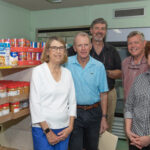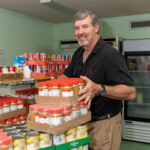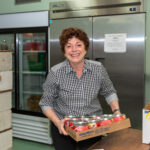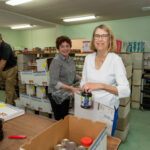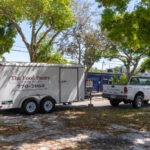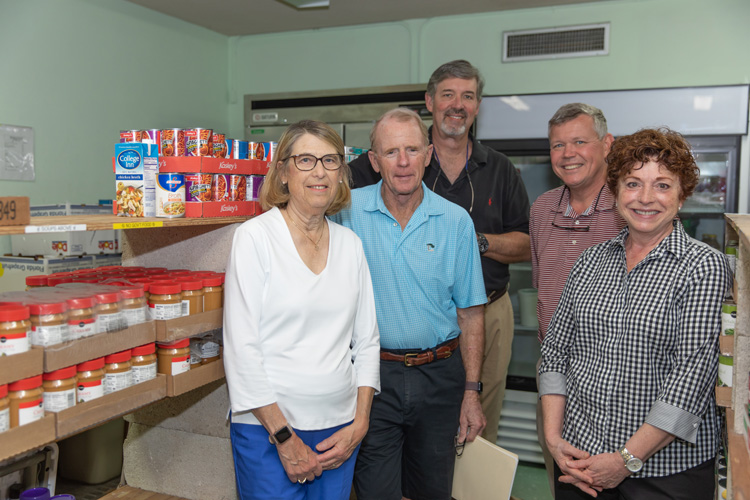
The Food Pantry of Indian River County has been performing a vital service to the community since 1987. Now, in these stressful and uncertain times, the services of this crucial nonprofit are going to be needed more than ever before.
Even before the COVID-19 pandemic, the Treasure Coast – Indian River, St. Lucie and Martin counties –had the dubious distinction of having the highest homeless population in the country, according to the U.S. Department of Housing and Urban Development’s 2019 Annual Homeless Assessment Report. The report bases its findings on a point-in-time count conducted annually during the last week of January.
Also before this latest catastrophe, more than half the Indian River County population had household incomes below a realistic survival threshold. With the addition of this pandemic, many low-income workers who were already living paycheck to paycheck are likely to lose their jobs, if they haven’t already.
To all of them, the Food Pantry, an all-volunteer nonprofit, is a godsend.
Scott Turner, whose mother was among the Food Pantry’s founders, says it began when volunteers from local places of worship banded together to feed the hungry. First Baptist Church generously donated rent-free-space around 1989, where it has remained ever since.
Turner and Tom Mackie co-chair a 10-member board, and roughly 45 volunteers assist in a wide variety of ways, such as picking up donated bread, transporting food from the pantry’s warehouse to the church, registering recipients, and making up and distributing food boxes.
Expenses are kept to a minimum, Turner says, so that “90 percent of the money that comes into this place goes back out as food.”
A lot of food.
When he first got involved about 15 years ago, Mackie says they were giving out between 80,000 and 90,000 pounds of food a year. Last year that number was 300,000 pounds and it will most certainly increase.
“It’s a whole different scale,” says Mackie. “We provide three to five days of what we say is emergency food per month to the underemployed and unemployed.”
Food boxes range from 10 to 15 pounds of goods for one person, and up to 50 pounds for a six-person family.
“And I tell you what, we got slammed today,” says Mackie. “Everyone is shutting down, so you’ve got all the service workers losing their jobs. We’ve been averaging about 750 families a month, but that’s about to take off.”
Turner explains that while they may serve up to 900 families in the summertime, winter is traditionally their slower time, when work is available in the service and citrus industries.
In addition to people who make their way to a pass-through window at First Baptist Church to pick up their allotment, the Food Pantry delivers to agencies and outreach groups, such as Our Father’s Kitchen in Gifford, which then distributes the food to elderly shut-ins.
Recipients register (the government requires people to self-attest their eligibility and what other assistance they may be receiving) and provide proof of ID. A social security number or birth certificate is required for each child.
“I find that my conversations with people have been an eye-opener,” says board member Ellen Zollenberg. “That’s really why I do this, because it’s a whole different world than I’m familiar with. It gets to you. As soon as I started here and saw the need, I just felt like I had to do something. We’re really making a difference.”
“I’ll tell you a story that absolutely stunned me,” adds board member Bonnie Simpson.
During the last recession, she remembers well-dressed people driving up in nice cars, embarrassed that they needed to ask for help. One elderly but beautifully attired woman was discovered slumped against the wall outside the Food Pantry. She hadn’t eaten in days and was faint from hunger.
“You would never have known if you looked at her, that she had no food,” Simpson says. “It’s always stunning.”
“Every story is different,” Zollenberg says in agreement, remembering another man who came to the window one day and simply said, “I’m hungry.”
Local places of worship, gated communities, businesses, civic, neighborhood and school groups contribute volunteers, money and shelf-stable food. The Food Pantry is also the recipient of local contributions to the annual U. S. Postal Service Food Drive, which student youth groups then help sort in the pantry’s warehouse.
“One summer we were hard on cash, and so the volunteers from Grand Harbor started an Octoberfest that raised about $7,000 or $8,000. Now they do something every year,” says Mackie.
“People from all over come in and bring food to donate it from drives,” says Simpson. “We’ve seen them for years and years and they’re like friends.”
Referencing the Consignment Gallery on 7th Avenue, Mackie says, “They’ve had a box there for a number of years and they solicit both food and money. Every month, they bring us a big box of food.”
“A lot of people, when they’re leaving for the summer, clean their pantries out and donate,” adds Zollenberg.
For the Love of Paws, a Fellsmere-based nonprofit, contributes packages of cat and dog food, says Mackie, “and that’s very popular, because people have pets.”
“And a lot of the homeless have pets,” adds Simpson, before sharing that feeding the hungry was instilled in her at an early age.
“I come from an Italian family and we didn’t have Christmas dinner until the poor people were fed, so they all got spaghetti and meatballs,” Simpson recalls.
In addition to food donations from local Publix stores, they receive a grant from Publix Charities; the Wabasso-based nonprofit Shining Light Garden provides fresh produce; and Pepperidge Farm supplies bread.
They purchase (a nominal handling fee) goods from the Treasure Coast Food Bank, including ‘reclaimed’ (past best-buy dates) meat and dairy collected by the Food Bank from supermarkets and frozen. Other foodstuffs are purchased by the pallet load from such discount stores as Save A Lot. Perishables are stored in two commercial refrigerator/freezers purchased through a John’s Island Foundation grant.
“We beg, borrow and steal wherever we can,” Mackie says with a laugh.
“We average about 1,000 pounds of meat each week,” adds Turner.
“The problem is, if you’ve been in the grocery store the last couple of days, everything is gone,” says Mackie. “So we’re not going to get meat to give away.”
As a member of the Community Church Mission board, Turner says he is aware of the needs of other local agencies and, while quick to point out that they’re all doing good work, he comments, “I believe that food is the only thing that you have to have. You’ve got to have food.”
In recent years, Mackie says they have been able to balance their roughly $100,000 budget, which is funded by donations and a few grants.
“It’s never enough,” says Simpson with regret. “It’s a big operation.”
Donations will soon be critical. This current crisis is clearly going to affect their organization financially, given that they will likely have to purchase more food to keep up with the increased demand.
“I don’t know what percent we can expect, but I wouldn’t be surprised if it were 20 or 30 percent,” says Mackie. “I think the big thing now is we’re going to have to wrestle with the unknown; we don’t know what we’re getting into. We know our demand is going up, so we need to figure out how to handle it. Our goal is that people shouldn’t go away hungry. No one should starve.”
The pantry is open five half-days each week: from 9:30 a.m. to 12:30 p.m. Monday, Wednesday and Friday; and from 2 p.m. to 5 p.m. Tuesday and Thursday. For more information, visit foodpantryirc.org.
Photos by: Denise Ritchie
Click HERE to see more or buy photos
- Ellen Zollenberg, Tom Mackie, Scott Turner, Martin Bireley and Bonnie Simpson
- Ellen Zollenberg, Tom Mackie, Scott Turner, Martin Bireley and Bonnie Simpson
- Scott Turner
- Bonnie Simpson
- Bonnie SImpson and Ellen Zollenberg
- The Food Pantry of Indian River County
- The Food Pantry of Indian River County
- The Food Pantry of Indian River County
- The Food Pantry of Indian River County
- The Food Pantry of Indian River County
- First Baptist Church

